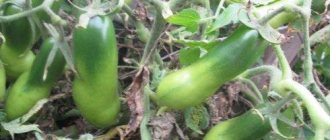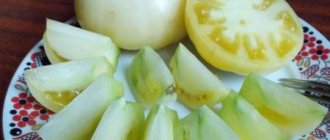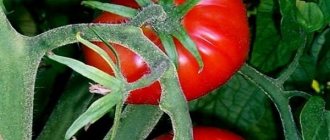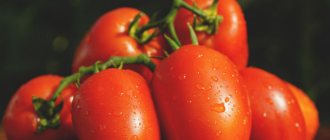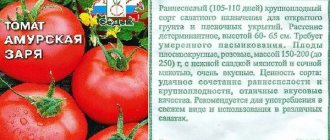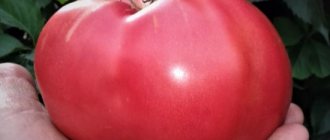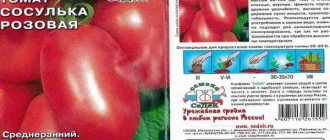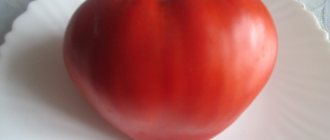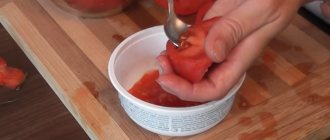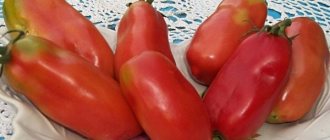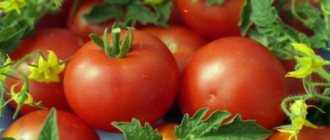The Chibis tomato, a highly productive and versatile variety, can be a discovery for many gardeners. According to farmers, it occupies a high position in the ranking of favorite tomatoes. Ideal for canning, pickling, and fresh consumption. It holds its shape remarkably well in marinade and has an exquisite taste.
| Height | Landing location | Ripening time | Fruit color | Fruit size | Origin | Fruit shape |
| Tall | Greenhouse, Open ground | Mid-early | Reds | Average | Variety | Plum-shaped or oval |
Description of Chibis tomato
The Chibis tomato variety was included in the State Register of Breeding Achievements in 2007. It is recommended for cultivation throughout Russia in open ground. Cultivation in a greenhouse increases fruit yield. The tomato belongs to the mid-early varieties; from sowing to fruit ripening it takes about 3 months, and in unfavorable conditions a little longer.
Main characteristics and description of the Chibis tomato variety:
- determinant, standard variety of tomatoes, bred by Russian breeders;
- the tomato stem is strong;
- The tomato bush is compact, not too tall - only 70–80 cm, and does not require garter;
- moderate pinching is allowed;
- the leaves are dark green and medium-sized, with irregularities and roughness on the surface;
- tomatoes have a thick stalk and a stem with an articulation;
- there is a simple inflorescence.
The presented description of the variety, photos and reviews of Tomato Chibis will help you determine the seedlings you need to buy.
Description of fruits
The Chibis tomato variety is an excellent pickling vegetable. Its durable skin prevents the fruit from spreading when pickled or salted. The tomato pulp is dense and has a slightly sweet and sour taste. The Chibis tomato variety shown in the photo has the following description of the fruit:
- a medium-sized tomato fruit weighs 50–70 g;
- the skin and pulp of the tomato are dense, bright red in color, dry matter content - 5.9%;
- pleasant sweetish taste due to the presence of a large amount of sugar;
- the smell of a real ground tomato;
- the shape of the tomato fruit is finger-shaped - an elongated tomato with barely outlined ribs and a tiny tip;
- the fleshy fruit has no more than 3 seed chambers.
Attention! Tomatoes are used for summer vegetable salads and pickling. Thanks to the dense skin and pulp of tomatoes, they can be transported over long distances and do not spoil for a long time.
Reviews
Irina, 34 years old, Kostroma region.
Our climate is harsh, frosts end late and start early. But some varieties of tomatoes ripen in open ground. And among them is Chibis. This is only my third year of planting. I have to shape it quite harshly, so I collect the first 2 brushes with red ones, and ripen the rest. There may be earlier varieties, but this one is very good at pickling and is ripe and green.
Maxim, 14 years old, Efremov
I’ve been helping my grandmother in the garden for a long time. She used to plant old varieties of tomatoes, but they suffered a lot. I persuaded them to plant several new ones. She liked Chibis the most. Neat tomatoes are easy to cut into salads, and they are delicious in marinade. We will expand the range of modern varieties.
Source
Characteristics of tomato
The Lapwing tomato is grown both in open ground and in greenhouses. It depends on the climate where you plan to grow the vegetable.
Productivity and fruiting
Ripening time depends on weather conditions and ranges from 90 to 110 days. Productivity varies depending on the conditions and characteristics of growth and care, respectively - with normal care you can harvest from 2 kg of tomatoes from a bush. From 1 sq. m in open ground you can get up to 15 kg of fruit under favorable growing conditions.
In a greenhouse, as a rule, the yield is higher. A feature of the variety is its friendly fruiting. It is recommended to harvest at a time when the tomatoes are not yet ripe, this way you can increase the yield for the season.
Area of application of fruits
Since tomatoes have fleshy pulp and a pleasant taste, they are consumed fresh. Tomatoes are suitable for preparing various salads and vegetable cuts. Due to their thick skin, they hold their shape well, so they are pickled and salted as a whole. Tomatoes can be salted in a barrel or canned in their own juice.
Resistance to diseases and pests
Since the tomato ripens quickly, it does not have time to become infected with the common tomato disease, late blight. The variety is resistant to blossom end and root rot. Most pests do not have time to damage tender tomato seedlings. Pests cannot cause serious damage to mature bushes. In order to prevent diseases, it is necessary to water the bushes with a weak solution of potassium permanganate once a month.
Advantages and disadvantages of the variety
Reviews and photos of those gardeners who planted Lapwing tomato allow us to determine the advantages and disadvantages. The positive characteristics of the Chibis variety include:
- high yield of tomatoes, especially if grown in a greenhouse - in this case you can get up to 3 kg of tomatoes from a bush;
- variety resistance to night temperature fluctuations;
- rich taste and tomato aroma;
- the thick stem and low growth of the Chibis variety allow it to withstand adverse weather conditions and not break during gusts of wind and heavy downpours;
- the variety is unpretentious and does not require special care;
- the fruits are stored for a long time and do not deteriorate during transportation because they have dense skin and pulp;
- high content of nutrients: manganese, magnesium, potassium and B vitamins.
The disadvantages of Chibis tomatoes include the possibility of infection of the bushes with late blight.
Advantages and disadvantages of the variety
Many summer residents appreciate Chibis tomatoes for their ease of care. Not every gardener is ready to devote a lot of time to planting; besides, beginners need to start with “simple” varieties. These tomatoes are undemanding to care and even if you follow the basic rules, they give a good harvest.
If agricultural practices are followed, each Chibis tomato bush produces up to 3 kg of fruit
pros
- good yield;
- low maintenance requirements;
- there is no need to shape and tie up, pinching (in this case, it is better to remove all shoots below the first flowering raceme);
- long shelf life;
- good transportability;
- an excellent option for whole-fruit canning;
- pleasant, balanced taste of Chibis tomatoes.
Minuses
- pulp of medium juiciness;
- not suitable for making tomato juice.
Growing rules
To get a good harvest of Lapwing tomato, you should sow seeds for seedlings. Planting tomato seeds in open ground does not guarantee good germination and strong bushes. Instructions for growing the Chibis variety are presented below.
Planting seedlings
Preliminary preparation and planting of Chibis tomato seeds requires the following actions:
- It is recommended to buy seeds from a reliable and trusted manufacturer. This way you can avoid mis-grading and poorly collected and processed seeds. From the offered product you need to choose the largest and thickest seeds.
- Before planting, seeds must be treated against possible diseases.
You can process it in the usual way - soak for 20 minutes in a 1% solution of potassium permanganate. After disinfection, be sure to rinse the seeds under running water. Treatment with a 2–3% hydrogen peroxide solution is used in a similar way. The product must be diluted with warm water and the seeds should be left for no more than 8 minutes. Advice! Be sure to treat the seeds with growth stimulants. This will make the seedlings sprout quickly and quickly. For the procedure, you can use folk remedies - aloe or potato juice. Special products are suitable - “Epin”, “Zircon”. Soaking should last no more than 18 hours. - Immediately after soaking, sow the seeds in the prepared soil. The best option is a mixture of purchased soil and humus (in equal parts). The latter can be replaced with vermicompost and sand.
- The soil is poured into shallow and wide containers. Seeds are sown to a depth of 3–5 mm in moist soil. The sowing pattern is 2x2 cm. After sowing, the containers are covered with polyethylene and placed in a warm place. Shoots appear in 5–7 days. Immediately after this, the containers are transferred to a bright place with a temperature no higher than 14 degrees. Tomato seedlings of the Chibis variety love light; if there is not enough light, it is recommended to add artificial light. Gradually the temperature in the room is increased.
- When 2 leaves appear, the seedlings are planted in separate containers and kept in the shade for several days. Water as the soil dries with settled warm water. Once a decade, seedlings are fed with complex mineral fertilizer.
The seeds are sown at the end of March, the seedlings will be ready for transplanting into open ground in May.
Tomato transplant
The seedlings are ready for planting in open ground after 45 days. It should have 5-7 true leaves and an emerging flower raceme. In order for the seedlings to take root well, they must be hardened off 2 weeks before planting. To do this, it is recommended to take the containers outside for one hour at first, gradually increasing the exposure to air. If the temperature does not drop below 14 degrees at night, you can leave the container outside at night.
You can plant it in the ground after the soil has warmed up to 15 degrees. The planting pattern for bushes is 60x60 cm, if the variety does not involve pinching. Water is poured into the prepared wells with humate diluted in it - 1 spoon per bucket. To prevent the seedlings from burning in the sun, they need to be shaded for 3-4 days.
Attention! If planting in a greenhouse is meant, all steps are repeated exactly as described, but earlier in time. The Chibis variety can be planted in a greenhouse after the soil has warmed to 10 degrees.
Subsequent care for tomatoes
Tomatoes are not watered for the first week, but then they should be watered regularly 3 hours before sunset once a week. Water consumption – bucket per 1 sq. m. During the period of flowering and formation of tomatoes, watering is increased to twice a week. Water must be poured directly under the root so that the leaves do not get wet and are not susceptible to various diseases.
Tomato bushes need to be fed once every 10 days with complex mineral fertilizers.
There is no need to carry out pinching of bushes. If you want to speed up the ripening of fruits, then you need to remove all the stepsons, but this affects the yield, it will be worse. There is no need to garter the Lapwing bush, since it is short and strong. In order for the tomatoes to turn red quickly, it is necessary to remove the leaves from the bush, but this procedure should be carried out gradually.
Agricultural technology
Kibiz is best grown in seedlings. It is easy to calculate the sowing time independently for each region, taking into account its climatic characteristics. Plants are ready for transplantation to a permanent location at the age of 55-60 days. The planting density, given the relative compactness of the bushes, is high - up to 5 - 9 pieces per 1 square meter. But you shouldn’t thicken the plantings too much to avoid the threat of late blight. During the growing process, gardeners often refuse to tie up and form a crop. But experienced vegetable growers recommend forming the plant into 3 - 4 stems, and if a large number of ovaries form, tie it to a support. The crop is undemanding in terms of care and is unpretentious to soils, but still prefers loose and fertile soils. Watering is carried out with water heated in the sun. During the growing season you need to feed the tomatoes 2-3 times.
Kibitz is loved by many vegetable growers for its unpretentiousness and productivity. Despite its popularity, the crop is most often grown not because of its taste, but because of the quality of the resulting tomato products and seals. If you follow agricultural practices, there will be no problems with the resistant variety. No particular complaints were found during the cultivation of the variety. A nice bonus is the ability to collect seeds yourself.
Care
The variety needs to be partially shaped so that the tomatoes receive enough light. Excess stepsons are broken off, and the foliage is thinned out (the lower leaves can be removed, but gradually).
It is advisable to tie the Lapwing tomato to pegs so that the fruits are not pulled back and the branches are not broken.
Water the plants every 10 days, every other time combining this procedure with fertilizing. Water-soluble mineral complexes, rotted manure, bird droppings, and plant infusions are used as fertilizers.
After watering, unmulched soil must be loosened so that a crust does not form on the ground. To avoid pests and diseases, weeds must be removed regularly.
Cut tomatoes. Salad pink varieties, lapwing, sweet bunch cherry.
Yield varieties of tomatoes for open ground
THE BEST VARIETIES OF TOMATOES THAT I WILL NOT REFUSE AND RECOMMEND TO EVERYONE! REVIEW OF YIELD VARIETIES.
